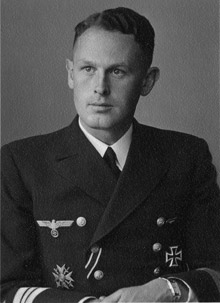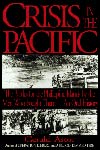Kiel, Germany
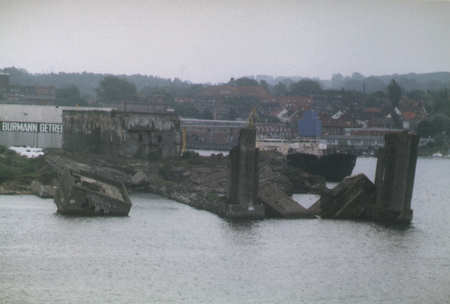
The Kilian bunker in June, 1996 - photo by Tim.
The U-Boat-Base "Kilian" in Kiel
The U-boat-base Kilian in Kiel was designed as a shelter for new-built U-boats and such with little damages. Docking of boats was not possible. The ceiling consisted of pre-stressed concrete-layers being in the end 4,8 m thick, the walls then had a strength of 3,3 m. There were two boxes each with a length of 150 m, the berths within stretched over 138 m per side. Therefore "Kilian" was the only base where two boats could be berthed one after the other. At least 12 VIIC U-boats could find place.
The pen was situated right within the water with hanging steel gates on the harbour side. There was no protection below the surface. On the North-West-corner a two-storey anti-air-raid-tower with accommodation space was erected with walls of only 30 cm strength. The base was built without a dry pit, between the three quays a wooden construction was laid as a working platform. Construction started in winter 1941/42, many workers came from surrounding working camps and also prisoners-of-war and deported people from the east being not allowed to find shelter in bunkers during air-raids. Their mortality rate was thus very high.
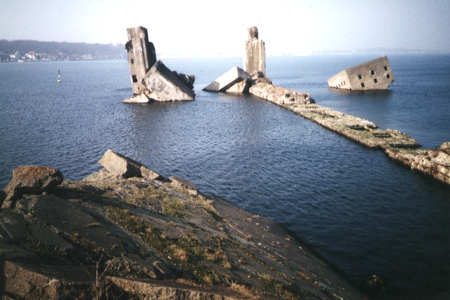
Kilian bunker in March, 1990 - photo by Tim.
In autumn 1942 the 1st concrete box measuring 42,3 x 8 m was sunk to create a foundation for the two outer and the inner wall. It was also then when the work box-section on the land side was completed. Until summer 1943 the walls were built, the construction of the ceiling lasted until November 43. On November 13th 1943 "Kilian" was consecrated, the first U-boat to enter was U-1101 six days later. The ceiling was then 3,5 m thick, the walls measured 2,5 m. Later the ceiling was strengthened with 1,3 m heavy concrete which still can be seen on the remaining work box today. Until the end of the works 200.000 m3 concrete were used by Dyckerhoff & Widmann AG. In January 43 1,200 men were working in two shifts around the clock, using 1200 m3 concrete per day. During the air-raids on Kiel "Kilian" took some hits which did not cause serious damage.

The Kilian bunker during sandfill in June, 1994 - photo by Tim.
There were no direct attacks neither by the RAF nor the USAAF on "Kilian" until the night from April 9th to 10th when the RAF started its 81st attack on Kiel with 359 aircraft during which the heavy cruiser Admiral Scheer was sunk and Admiral Hipper and Emden seriously damaged. Just 1000 m away the southern gate of the "Kilian" was destroyed by a bomb, its steel plates still lying on the harbour bottom. Inside the box the small U-4708 was lying close to the larger U-170 due to some testing works. There were 5 workers and 2 crew members on board. U-4708 was damaged by steel plates flying around and sprang a leak. The pressure within the box caused by the explosion was such intense that the instruments on board U-170 simulated a 40-m-dive for some minutes. All people in the box died immediately. U-4708 was pushed into the air, collided with the pier and sank within a few moments. Six of the men trapped on board managed to get into an air-bubble, three climbed from there into the tower and escaped in a hard struggle against the rising water, the bodies of the five other remained on board until today. The crew of U-170 rescued the survivors.
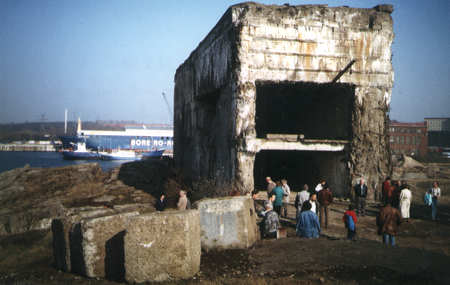
Kilian bunker in March, 1990 - photo by Tim.
U-170 managed to leave the box and then started producing electricity for the bombed Howaldtswerke-yard before leaving to Horten, Norway, on April 27th 1945. The last days of the war saw U-393, U-475, U-2512 and U-1162 in the base which was by then standing in an area of total destruction. The last air-raid was at midnight on May 2nd 45. Two hours later the u-boat crews were told to head to sea or blow up their ships. Some hours later U-475 was scuttled in the harbour, U-393 was attacked off Holnis, two men being killed, the other ships were scuttled off Flensburg shortly afterwards.
After the war divers of the "Disposal Group" inspected the wreck of U-4708, and it was successfully identified as wreck "No. 28, new build no. 950". Attempts to raise the wreck with air pressure failed. On September 1st 1945 the Guardian Division engineers under the leadership of Lt. Col. EN Blickford started the preparations for blowing up the pen. It took three weeks to drill 288 holes and inject 0,57 kg explosives into each. 107 bombs with 113 kg explosives were also brought into the building and, maybe, some other ammunition. The merchant ship "Jan Wellem" was anchored in a distance of 120 m to protect the city from the expected flood wave. On October 25th the at least 12,3 t explosives detonated and caused not only the mid wall and the ceiling to be destroyed but cut off also the outer walls. Tons of concrete buried U-4708 and some small craft. In September 1959 also the remaining Southern entrance of "Kilian", which until then had still formed a fragmented gate was blown up due to its lag of stability by Harry Stallzus. Before this he raised a sunk Seehund midget boat in front of the pen, its machine doing further service until the 80s in his motor-boat "Hella". He also raised some steel and other scrap from the bottom.
In 1989 some divers of the German navy inspected the underwater-world of "Kilian" in order to trace U-4708 but had serious difficulties to get to the wreck now being caught in a tunnel beneath the sunken ceiling and almost completely covered by mud in a depth of 8m.
Another remarkable post-war-event was the sinking of the pirate radio ship "Galaxy", better known as the famous "Radio London" and in war days a US-minelayer of 800 ts called "King" and fighting off Japan, on April 19th 1979 after five years of neglection in the North box. On August 16th 1986 salvage work started due to oil spilling out of the rusting hull, but it was not before August 30th that the giant floating-crane "Hebelift 3" was able to raise the wreck which was then scrapped nearby. In May 1994 several holes in the "Kilian" were filled with sand to prevent the possible explosion of remaining explosives.
During recent years there was an intense public and political discussion whether "Kilian" should be preserved as a war-memorial but now it looks like it will be removed some day to give way for civil harbour expansion plans in the near future.
Today the ruin is characterized by the remaining stumps of the South gate's entrance and some ceiling remains blocking it by leaning against them. The North gate was completely destroyed, only the cube of the mentioned anti-air-raid-tower showing with a dramatic list half sunken above the surface. The middle pier is still visible with a height of partially about 4 m above the water, the rough surface now being covered by plants. In the rear also some parts of the ceiling remained resting on the massive walk-system which led crosswise through the pen there and also had access to other parts of the yard. Above it rises most of the working box still to its full height, only one side being cut off. It was not blown up completely to prevent some yard-installations from being destroyed too. A half-sunk barge lying in shallow water is now partially buried in the sand fill which looks like a little beach in the North box. There are also lots of debris of the Howaldt yard which formerly owned the whole area which is now in communal hands. At low tide, the high rising parts of the outer walls and the sunk ceiling can be detected weed-covered. There is no official access to "Kilian", but it's possible to reach the ruins by boat or via the surrounding harbour zone and also do some interesting diving. But one should be prepared to be traced by the water-police as there is some danger of parts collapsing which happened at least in 1996.
Access to Kilian today - Kilian is gone for good
In late October 1998 public access was allowed to Kilian, guides being available (probably only for special occassions though). The access was by a circle track around the area. Between 1999 and 2002 the bunker was demolished to make space for cargo. This Google maps image shows the area as is it today. Our Gallery section also shows the demolition of the bunkers [this is an edit to the original text].
The U-Boat-Base and Yard "Konrad"
The 2nd base to be built in Kiel was "Konrad", constructed in a comparatively easy way by housing the existing dry dock III of the Deutsche Werke. This work was done under the leadership of Wayss & Freitag AG. The purpose was to shelter boats during small works, and its capacity was 5 VIIC U-boats. In April 1943 work started. The foundations were laid outside the old dock walls to avoid difficulties caused by the weight of them. Dock III remained flooded so that earth could be removed by ship. Dock IV right beside was filled up to provide space for building equipment. In August 1943 the deeply laid foundations were completed, wall construction started in December 43, and a three-storey work box installed down to the bottom of the dock.
Original plans were changed in February 1944 to complete "Konrad" as a bomb-sheltered yard so that an additional lock had to be built 28 m into the existing harbour basin. This part was erected on sunk concrete-blocks, the first of which was moved into position on February 16th 1944. On April 19th 1944 the construction of the ceiling commenced. 200 layers were put on the side walls with a speed of 16 per day which was about 13 m. In an air-raid in the night from 23rd to 24th of July 628 RAF-bombers attacked the shipyard and damaged the building site with 10 bombs. Works were restarted not before August 15th, another attack followed during the night from August 26th to 27th so that "Konrad" was completed just in October 1944. A direct hit in the night from April 13th to 14th caused only neglectable damage. In the meantime the construction of u-boats had begun, first equipment to be installed on October 2nd 1944. Until spring 1945, sections of XXI submarines were built, in March 1945 Seehund midget submarine-construction in three sections started, but did, of course, not get too far.
In October 1946 "Konrad" was blown up by the allies, the debris remaining until the 60s. For the construction of new, large shipbuilding halls of the Howaldtswerke Kiel AG the four former docks, having been filled up with sand after the war like the whole yard-basin, had to be excavated. During this process some shattered "Seehund"-wrecks were found, also the warship "Brummer" was still lying as it had been sunk in the dock next to "Konrad", buried, like other sunk craft traces of which could still be detected nowadays, in sand since. The removal work started in October 1961 and lasted until May 1962. Large amounts of explosives were needed to cut the 180.000 m3 into pieces small enough to be handled. Nothing remains today, and there is no access to the whole area as it belongs neither to the Howaldtswerke Deutsche Werft AG nor to the adjacent fitting-out basin of the Navy. Only a huge area of grass still partially marks the outline of the artificial basin where "Konrad" was situated.
(Main source the highly recommend book from Sönke Neitzel:
Die deutschen Ubootbunker und Bunkerwerften)
